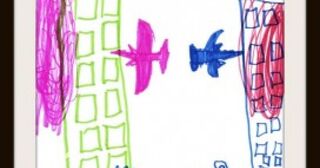
Kid’s Drawing of Twin Towers
Supply: © 2021 Courtesy of Cathy Malchiodi, PhD
Like a lot of you, as we speak I’m recalling many reminiscences on this twentieth anniversary of the occasions of Sept. 11, 2001. A few of these reminiscences are from what I noticed by way of televised information, others throughout the months after the catastrophe. As a trauma specialist, that day grew to become a milestone, progressively shaping how I proceed to revise my work as a psychologist and expressive arts therapist with every trauma and loss survivor throughout these previous twenty years.
Within the weeks following the terrorist assaults, I used to be touring with my mentor on the time, baby psychiatrist and trauma specialist Lenore Terr, MD, for lectures we had scheduled earlier than the sudden occurred. We traveled to Chicago, San Francisco, and different massive cities to teams of practitioners grateful to have the ability to come collectively to speak about “what occurred” and the way we may be impacted by the occasions that had been nonetheless uncooked and unfiltered in physique and thoughts.
Youngsters’s Drawings of 9/11: Increasing Our View of Traumatic Occasions
Throughout these trainings, I additionally started my very own analysis of types into how kids had been responding in photos and narratives about 9/11. In every metropolis we visited, I sat and listened to a whole lot of school-aged kids in varied lecture rooms, recapping the occasions and speaking about their photos. These moments taught me so many issues about trauma, however particularly the significance and impression of expressive approaches after a mass trauma. On reflection, I realized a number of issues particularly:
Picture-making stimulates narrative. We now know from a number of analysis research about why easy image-making could also be vital because it pertains to post-traumatic occasions (Malchiodi, 2003; 2018; 2020). Drawing whereas speaking about an emotionally laden occasion can truly stimulate two to a few instances as a lot narrative than simply speaking alone (Gross & Haynes, 1998). Working with kids, seeing their drawings, and listening to their tales helped me to know what Damasio (2000) found in regards to the connection between “implicit tales” turning into “express communications,” image-making (implicit communication) jump-starts the method of narrative (express communication). As I later wrote in 2003, expressive approaches could also be helpful in serving to people reconnect “feeling with considering.” In different phrases, the implicit story (the sensation of what occurred) is the start line for express narration.
Picture-making is a type of re-exposure to sensory reminiscences. In my interviews with kids post-9/11, it grew to become evident that drawing photos or impressions of traumatic occasions re-exposes people to a few of the similar sensory (visible, auditory, kinesthetic, and tactile) reminiscences of that occasion. For some, this is a chance to make that means of an emotionally laden or upsetting expertise. For others—significantly these with unresolved trauma reactions—it could set off avoidance, intrusive reminiscences, or anxiety, requiring strategic and delicate intervention on the a part of the therapist.
Picture-making is impacted by what’s skilled. Essentially the most iconic picture—the dual towers being hit by planes—grew to become the seminal depiction of 9/11 by most kids. However I used to be shocked by one group of kids who had repeatedly witnessed tv footage of individuals leaping from the World Commerce Middle Towers. I used to be challenged to reply, “why did these individuals leap?” as a result of what these kids noticed made no sense, understandably frightened by adults’ selections to leap to their deaths. Takeaway: media does make a long-lasting impression on how we encode occasions.
Search for the helpers in kids’s drawings. Mr. Rogers instructed that when one thing dangerous occurs to us as kids, you will need to search for the helpers. What I realized from these a whole lot of kids was merely this: in the event you had helpers or believed that assist was coming, you had been ready to deal with tragedy extra successfully. Youngsters who had earlier traumas and lack of caregiver assist had been much less prone to embody photos of serving to adults equivalent to first responders than these kids who had been extra resilient (Malchiodi, 2020). This statement was supported just a few years later once we noticed the aftermath of Hurricane Katrina. In that scenario, baby survivors of that catastrophe skilled far completely different circumstances than these from 9/11. A lot of them didn’t have social assist from “serving to adults,” surviving the hurricane and its aftermath with out well timed rescue and below harsh, socially stressful circumstances.
I’m grateful as we speak for these moments of studying as a result of who will get such a once-in-a-lifetime probability to be taught in such a strong approach about reparation, restoration, and restoration. That gratitude is coupled with a lingering sorrow for individuals who had been instantly impacted on this present day twenty years in the past. Could we proceed to be taught from these experiences and make that means from a day that actually modified the world.
Source link













